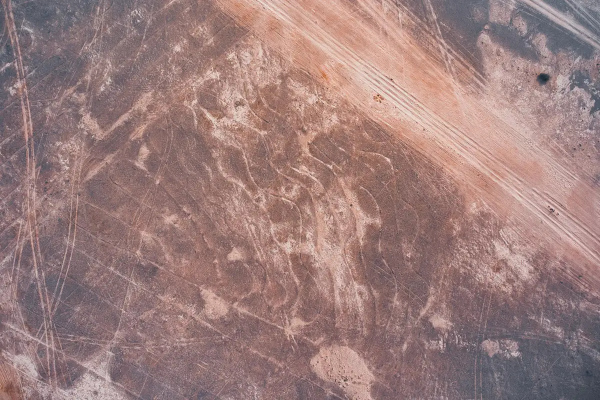The Thar desert, in India, is the scene of an exciting and recent archaeological find: mysterious ancient drawings carved into the ground, on such an immense scale that they probably never could be fully glimpsed by those who made them, according to the researchers.
As Science Alert collects, they are examples of geoglyphs: giant hand-made representations and patterns built or carved into the ground, often occupying such a reach that the true appearance of their shapes only it can be seen from a great height.
Among all the known geoglyphs of historical relevance, including the famous Nazca Lines, in Peru, The Thar Desert formations appear to be what may actually be the largest graphic representations ever designed by humans.
“So far these geoglyphs, the largest discovered worldwide and for the first time on the Indian subcontinent, are also unique in their enigmatic signs“explain the researchers in a new article detailing the finding.
Discovered by a couple of independent researchers from France, Carlo and Yohann Oetheimer, the new geoglyphs were detected using Google Earth, during a virtual survey of the Thar Desert region (also known as the Great Indian Desert); This region covers about 200,000 square kilometers of territory between India and Pakistan.
In the midst of this vast, dry landscape, the Oetheimer brothers identified several sites located around the Jaisalmer’s ‘Golden City’, marked by geometric lines that resemble geoglyphs.
A closer inspection during a field study in 2016 using an unmanned aerial vehicle (UAV) revealed that some of the identified sites were furrows dug for tree plantations, but it also helped reveal a group of enigmatic line formations apparently absent from trees.
In particular, two stood out “remarkable geometric figures” of exceptional character near the town of Boha: a giant spiral and a snake-shaped drawing, each connected by a group of sinuous lines.
The lines that make up these figures are lines etched into the ground, which go up to 10 centimeters deep and range 20 to 50 cm wide. While these dimensions up close may not be noticeable, what they end up forming is not.
The largest identified geoglyph, the giant asymmetric spiral (called Boha 1), is made of a single looped line that spans 12 kilometers, over an area 724 meters long by 201 meters wide.
To the southwest of this enormous vortex shape rests a serpentine geoglyph (Boha 2), composed of a line 11 kilometers long, encompassing a serpentine figure, a smaller spiral, and a long sequence of bustropheedon-style lines running back and forth.
Other small geoglyphs can also be found in the Boha region (including a meandering lines feature, called Boha 3), which in total includes around 48 kilometers of lines still visible today, which the researchers estimate once stretched for about 50 miles.
“The giant spiral and serpentine figure are definitely the main points of interest, closely related to Boha 3, suggesting that all other geoglyphs were created as a framework for this ensemble,” the researchers write. “Due to their spatial contiguity, patterns 1, 2 and 3 can be perceived as a sequential project“, they point out.
What do they mean
What this project represents, and who created it, is not yet completely clear, but the researchers suggest that the formations are not ancient geoglyphs but relatively recent, maybe at least 150 years old; They may also be contemporary with Hindu memorial stones found in the area.
Without definitively knowing more about the identity of their creators, it is difficult to speculate on the function and meaning of these giant geoglyphs, but researchers nonetheless they have some ideas.
Given that the region is flat and the creators of these structures would not have been able to assimilate their creations (which would have required being about 300 meters high), the authors say that it is unlikely that these designs were conceived as a form of artistic expression. contemplated from the ground, but could have served as a type of unknown cultural practice in its elaboration.
“This invites us to consider religious, astronomical and / or cosmological meanings,” say the researchers. “Due to their uniqueness, we can speculate that they could represent a commemoration of a locally observed exceptional celestial event“, they add.
While we still don’t know much about these mysterious markings and their semantic relationship to each other, the researchers say the strange motifs are notable for their unmatched size in particular, but also for their design and implementation, which would have involved the knowledge of mathematics and planimetry.
It will be up to future research to follow these fascinating clues, but the Oetheimer brothers hope that, for now, the publication of their study will influence Indian authorities to protect the heritage of these mysterious lines, before lhuman activity disturbs them and hides them even more.
“After extensive research, we consider the Boha geoglyphs to be man-made geometric figures abstract and organically organized largest discovered so far, “the researchers write.
“We remain convinced that these unique geoglyphs are closely related to their geographic and cultural context, and possibly contain a linked universal message. to the sacred and to the cosmos“, they conclude.
Source: Explica.co
You may also like
-
India Can’t Afford to Remain Stagnant at this Juncture, Says PM Modi; Asks People to Buy Locally-Made Goods
-
Stolen Artefacts to be Returned to India from Scotland Museums
-
Legendary Singer Lata Mangeshkar Passes Away At the Age of 92
-
Netaji’s Hologram Statue at India Gate
-
10th Century Stone Idol of Goat Head Yogini IllegallyRemoved from A Temple in Lokhari, Banda, UP Being Returned to India
